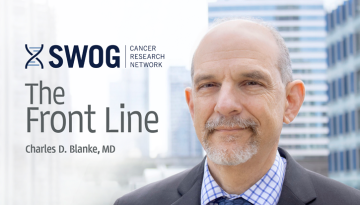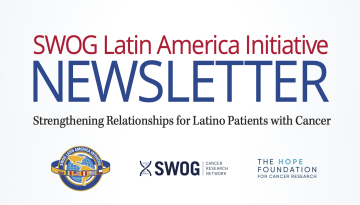New Drug Approval: A Secondary Goal for SWOG
SWOG trials aim to change or affirm standard of care in cancer treatment. In semi-rare cases, studies lead to new regulatory endorsements. Indeed, it’s not every day that our trial data get a new therapy approved. But we’re having one of those (very good) days.
This month, the European Medical Association Committee for Medical Products for Human Use approved a SWOG-tested triplet for patients with multiple myeloma not eligible for stem cell transplant. This means thousands of European patients each year will have a new treatment option, thanks to the SWOG Cancer Research Network and our S0777 trial.
Getting this approval is particularly a triumph for our statistics and data management staff. But getting there required traveling a very long, very arduous road.
Dr. Brian Durie and his team launched S0777 back in 2008, aiming to test whether the addition of bortezomib to lenalidomide and dexamethasone significantly lengthened progression-free survival in myeloma. It did, and The Lancet published those results in 2016. In S0777, 471 eligible patients with previously untreated myeloma were randomized to initial treatment with or without bortezomib. With the addition, Durie and his colleagues found an approximately one-year improvement in both progression-free and overall survival.
These drugs were already approved by FDA, but the SWOG findings changed how American doctors used them. After the change in standard of care in the states, our partners at Celgene Corporation – the makers of lenalidomide – aimed to get the triplet combo approved in Europe. SWOG was approached to get the S0777 data “registration ready” for submission to the EMA.
This type of retrospective data management and statistical work is brutal – it’s both voluminous and rigorous. In order to ensure total data integrity and patient safety, SWOG site staff had to re-consent 214 S0777 patients and gather new medical history data. And SWOG staff had to confirm all new trial data and manage over 3,000 case report forms sent in by sites. Reviews of study data netted 9,000 queries that were posted out of our stats center. Auditors also made 240 monitoring visits that represented over 1,000 monitoring days! Every participating site was visited at least once, and often twice, with data vetted for accuracy and completeness.
This work took about 18 intensive months, resulting in a final data set submitted to Celgene in September 2017. Our work was then submitted to the EMA. This month, based on that data, the EMA gave the green light for the drug labeling for the triplet. Brazil also approved the combo last month.
Cheers went up in Seattle at our statistics and data management center, which took on the bulk of this Herculean task. The staff at Cancer Research And Biostatistics spent thousands of hours on the project, involving the original S0777 lead statistician Antje Hoering plus Rachael Sexton, Sarah Basse, Cathy Rankin, Evonne Lackey, Jeri Jardine, Laura Kingsbury, and Sam Dzingle leading the mammoth data project. I want to thank them all, along with so many of their data management colleagues who pitched in. Thanks also to Dr. Durie and his S0777 team, and SWOG myeloma chair Dr. Bob Orlowski, who has been a long-time champion of the original trial and the retrospective project. And an especially warm thanks to the SWOG member sites that worked with our team on this project. They’re real heroes here.
This work is important for two reasons. Of course, the main one is that European patients with myeloma now have a new treatment option. In addition, after all that analysis and scrutiny, our original data held up. Overall survival rates, and progression-free survival rates, were virtually the same in the new data set as those found in the old data set. Our data were 100% replicable – which is a not insignificant goal of good research. Or, as I like to say, not chopped liver!
Other Recent Stories



